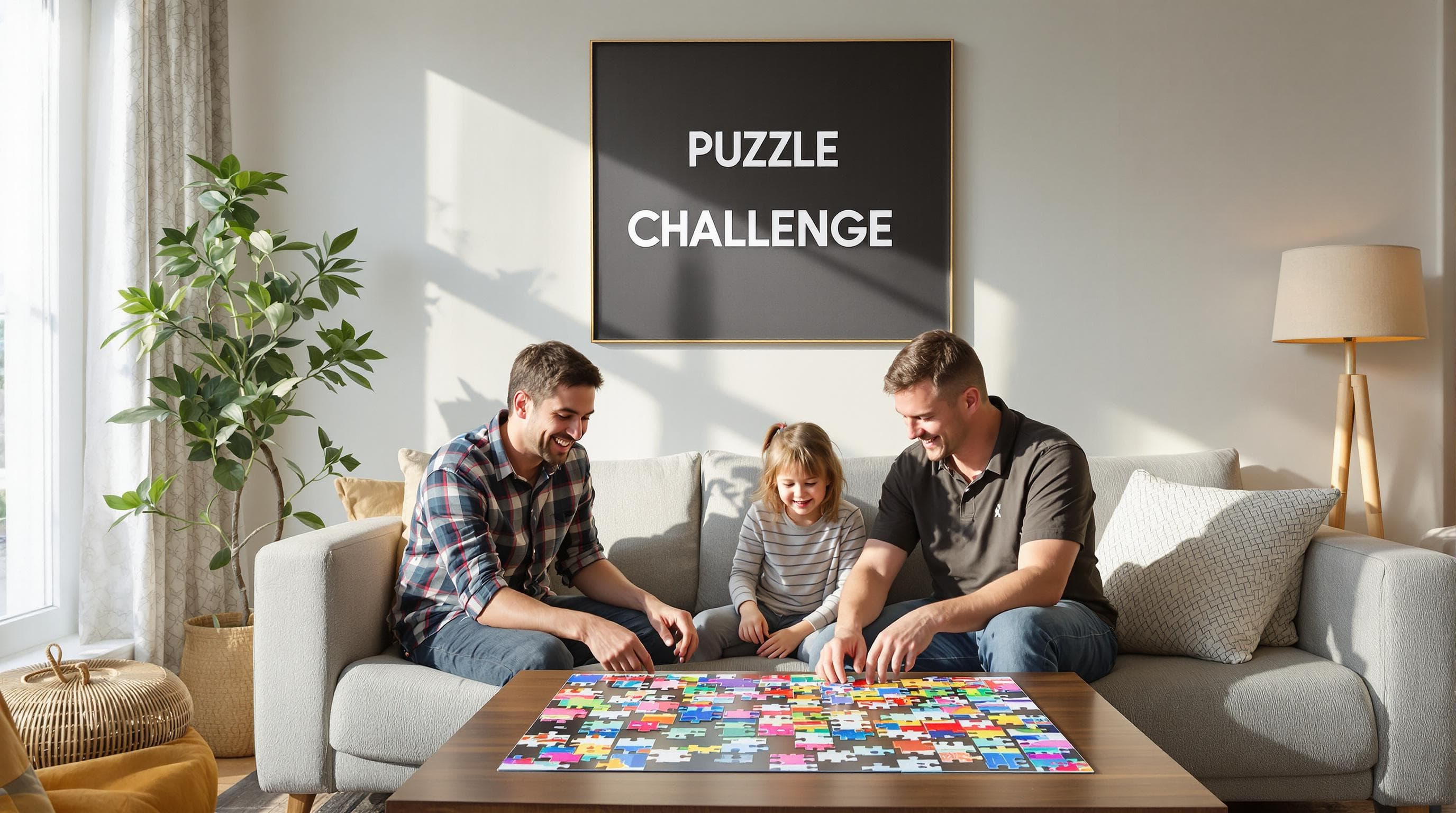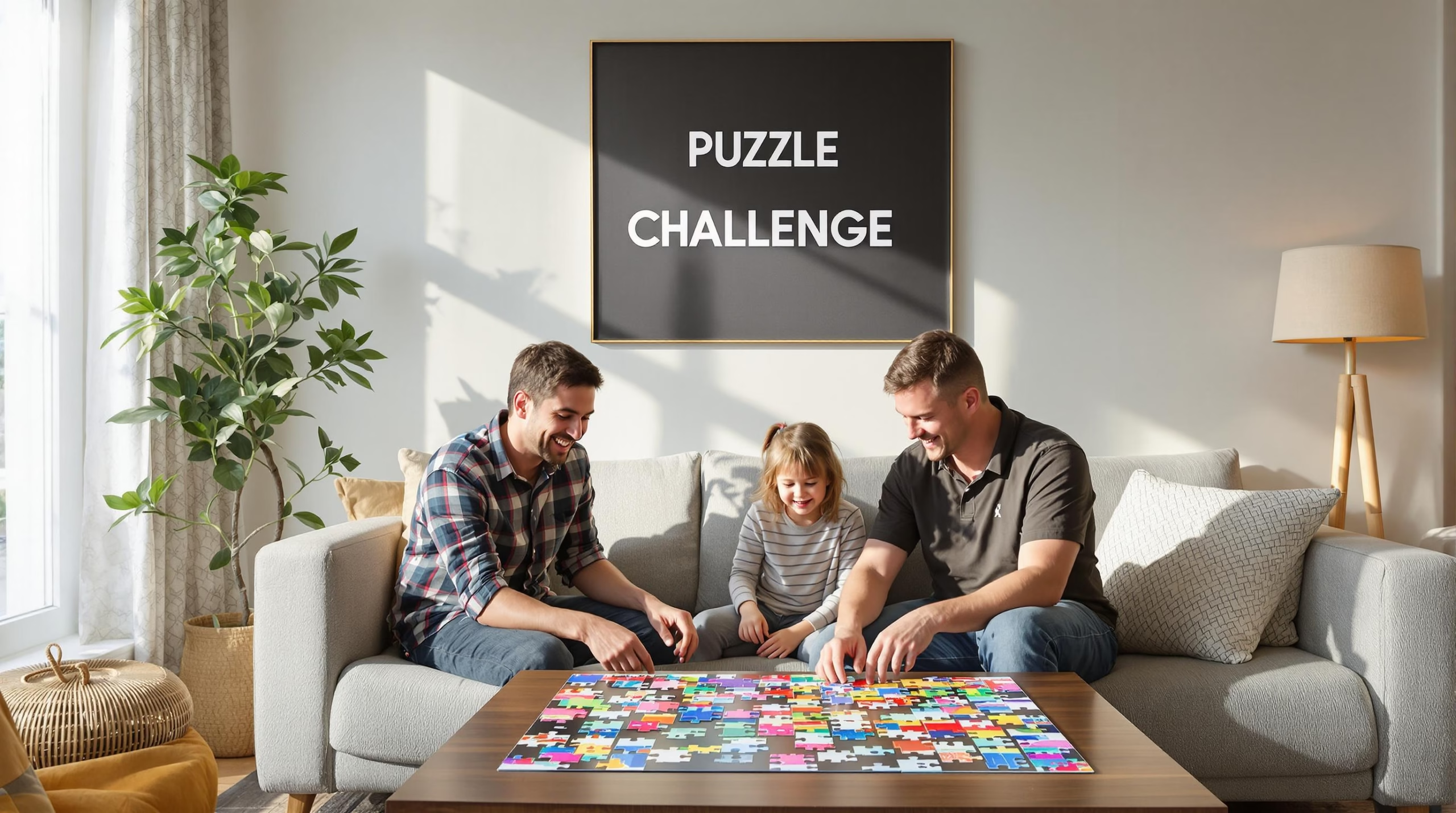
Jigsaw puzzles have been fascinating people for centuries, bringing together art, challenge, and quiet satisfaction in every piece. And yet, what surprises many is that the global jigsaw puzzle market is projected to reach a staggering $2.4 billion by 2032. Despite their vintage roots, jigsaw puzzles are now riding a wave of digital innovation, eco-conscious design, and immersive collaboration that even your tech-loving friends would not expect.
Table of Contents
- Understanding What Are Jigsaw Puzzles
- The History And Evolution Of Jigsaw Puzzles
- Benefits Of Jigsaw Puzzles For All Ages
- Popular Trends In Jigsaw Puzzles For 2025
Quick Summary
| Takeaway | Explanation |
|---|---|
| Cognitive Benefits | Jigsaw puzzles enhance critical cognitive skills such as pattern recognition, visuospatial reasoning, and memory, making them valuable mental exercises for all ages. |
| Emotional and Social Interaction | Completing puzzles fosters a sense of accomplishment, reduces stress, and promotes social interaction, making them ideal for family and group activities. |
| Diversity in Puzzle Types | Puzzles come in various formats, including traditional and 3D options, catering to different interests and levels of difficulty, appealing to both novice and experienced enthusiasts. |
| Trends in Sustainability | Manufacturers are increasingly using eco-friendly materials and engaging consumers through community-based challenges, reflecting a growing demand for responsible production practices. |
| Innovative Design Trends | Technological advancements are introducing immersive experiences like AR and VR puzzles, while thematic collections allow enthusiasts to engage with their personal interests and preferences. |
Understanding What Are Jigsaw Puzzles
Jigsaw puzzles are intricate and engaging recreational activities that challenge individuals to reconstruct an image by strategically fitting together numerous irregularly shaped pieces. According to Britannica, these puzzles originated in 18th-century England as innovative educational tools, initially designed to teach geography by creating intricate map representations.

The Basic Anatomy of Jigsaw Puzzles
At its core, a jigsaw puzzle consists of multiple interlocking pieces that, when assembled correctly, reveal a complete picture or design. The Library of Congress defines jigsaw puzzles as puzzles composed of small pieces typically made from pasteboard or wood, featuring unique shapes and edges that require precise manipulation and spatial reasoning to connect.
These puzzles come in various complexity levels, ranging from simple designs with fewer pieces suitable for children to elaborate images with thousands of intricate components that challenge even experienced puzzle enthusiasts. The pieces are carefully cut to interlock, creating a seamless image when correctly positioned.
Types and Complexity of Jigsaw Puzzles
Jigsaw puzzles offer remarkable diversity in design, difficulty, and purpose. Some common categories include:
- Traditional Picture Puzzles: Featuring landscape scenes, artwork reproductions, or photographic images
- 3D Puzzles: Three-dimensional constructions that create architectural models or complex structures
- Gradient or Monochromatic Puzzles: Challenging designs with similar colors that require advanced problem-solving skills
Merriam-Webster’s definition emphasizes the core challenge: fitting irregularly cut pieces together to form a complete picture. This process demands patience, spatial awareness, and strategic thinking.
Puzzle enthusiasts appreciate these activities not just as entertainment, but as mental exercises that enhance cognitive skills like pattern recognition, short-term memory, and problem-solving abilities. Whether completed alone or as a group activity, jigsaw puzzles offer a unique blend of entertainment and mental stimulation that appeals to people of all ages.
From children learning hand-eye coordination to adults seeking relaxation and mental challenge, jigsaw puzzles continue to be a beloved pastime that combines artistic appreciation with interactive problem-solving.
To help readers easily distinguish between the different types of jigsaw puzzles and their features, here’s a summary table of common categories and their characteristics:
| Puzzle Type | Description | Typical Difficulty |
|---|---|---|
| Traditional Picture Puzzle | Landscape scenes, artwork reproductions, photos | Easy to Hard |
| 3D Puzzle | Architectural or structural models in three dimensions | Moderate to Hard |
| Gradient/Monochromatic Puzzle | Similar or single-color pieces for a higher challenge | Hard |
| Pop Culture Puzzle | Designs from movies and TV, iconic media moments | Moderate |
| Artistic Reproduction | Famous artwork, museum-quality images | Moderate to Hard |
| Nature & Landscape Series | Global scenery, wildlife | Easy to Moderate |
The History and Evolution of Jigsaw Puzzles
According to the Museum of Play, the fascinating journey of jigsaw puzzles began in the mid-18th century with an innovative approach to educational tools. Around 1760, English mapmaker John Spilsbury pioneered the concept by creating the first puzzle prototype – a wooden map carefully cut along geographical boundaries, designed to help students learn world geography interactively.
Origins and Early Development
Europeana’s historical research reveals that early puzzles were primarily educational instruments. London cartographer John Spilsbury initially sold ‘dissected maps’ – wooden pieces cut along country borders that challenged learners to reassemble geographical regions. These early puzzles were expensive, handcrafted items primarily accessible to wealthy families and educational institutions.
The manufacturing process was labor-intensive. Craftsmen would carefully mount maps or images onto wooden boards and use hand-operated fretsaws to cut intricate patterns. Each piece was meticulously crafted, making puzzles rare and valuable educational resources during this period.
Popularization and Cultural Significance
Britannica notes that jigsaw puzzles experienced remarkable transformations throughout different historical periods. The early 1900s marked a significant turning point, with puzzles transitioning from exclusive educational tools to popular entertainment. The Great Depression of the 1930s particularly catalyzed their widespread adoption, as they provided an affordable and reusable form of entertainment during challenging economic times.
During this era, puzzle manufacturers began producing more diverse and aesthetically pleasing designs. Images expanded beyond maps to include paintings, biblical scenes, landscapes, and eventually photographs. Mass production techniques made puzzles more accessible to broader social classes, transforming them from elite educational instruments to mainstream recreational activities.
Technological advancements further revolutionized puzzle production. Die-cutting machines replaced manual fretsaw techniques, enabling faster, more precise piece creation. Cardboard gradually replaced wooden bases, making puzzles lighter, cheaper, and more widely available. This technological evolution democratized puzzle-solving, turning it into a global pastime enjoyed by people across different age groups and socioeconomic backgrounds.
The evolution of jigsaw puzzles reflects broader societal changes – from exclusive educational tools to universal entertainment mediums. What began as a specialized learning technique has transformed into a beloved global activity that continues to challenge, entertain, and connect people through the simple yet profound act of piece-by-piece problem solving.
Here is a timeline table summarizing the key milestones in the history and evolution of jigsaw puzzles:
| Period/Era | Key Milestone/Development |
|---|---|
| Mid-1700s (~1760) | John Spilsbury creates first dissected map (educational tool) |
| Late 1700s–1800s | Handcrafted wooden puzzles, mainly for wealthy and schools |
| Early 1900s | Transition to popular entertainment, broader themes emerge |
| 1930s (Great Depression) | Puzzles become affordable, mass-produced, widespread use |
| Mid-1900s | Mass production, variety in designs and materials increases |
| Late 1900s–2000s | Introduction of die-cutting, switch to cardboard bases |
| 2020s–2025 | Digital innovation, sustainability, AR/VR, community trends |
Benefits of Jigsaw Puzzles for All Ages

Jigsaw puzzles are more than just entertainment they are powerful cognitive tools that offer significant mental and emotional benefits across different age groups. Research published in Frontiers in Aging Neuroscience highlights the substantial cognitive advantages of engaging with these intricate problem-solving activities.
Cognitive Enhancement and Mental Fitness
Puzzle solving is a comprehensive brain workout that stimulates multiple cognitive functions simultaneously. A systematic review in BMC Geriatrics demonstrates that these activities significantly improve visuospatial reasoning, visual perception, and memory skills. For children, jigsaw puzzles help develop critical thinking and spatial awareness, while for adults and seniors, they provide crucial mental stimulation that can potentially slow cognitive decline.
The process of assembling a puzzle requires multiple cognitive skills working in harmony. Individuals must analyze shapes, recognize color patterns, remember piece locations, and strategically plan their assembly approach. This complex mental engagement helps strengthen neural connections, potentially improving overall brain plasticity and cognitive resilience.
Emotional and Psychological Well-being
Beyond cognitive benefits, jigsaw puzzles offer remarkable psychological advantages. The methodical process of piece placement provides a meditative experience that reduces stress and promotes mindfulness. Completing a puzzle generates a sense of accomplishment and boosts self-esteem, creating positive emotional feedback that can counteract feelings of anxiety and depression.
For families and social groups, puzzle solving becomes an interactive experience that fosters communication, collaboration, and shared achievement. The activity encourages patience, promotes gentle competition, and creates opportunities for meaningful social interaction across generations. Children learn problem-solving skills, while adults and seniors enjoy cognitive engagement and social connection.
Physical and Developmental Benefits
Puzzle solving also contributes to physical skill development, particularly fine motor coordination and hand-eye coordination. For young children, manipulating puzzle pieces helps develop precise finger movements and spatial understanding. For older adults, continued puzzle engagement can help maintain manual dexterity and prevent motor skill deterioration.
The tactile and visual nature of jigsaw puzzles makes them an excellent tool for learning. They teach persistence, strategic thinking, and the value of breaking complex problems into manageable components. Whether used in educational settings, therapeutic environments, or as a leisure activity, puzzles provide a unique blend of challenge and enjoyment that supports holistic personal development.
From enhancing cognitive functions to providing emotional balance, jigsaw puzzles represent a versatile activity that adapts to the needs and capabilities of individuals across all life stages. They demonstrate that learning and personal growth can be simultaneously challenging, enjoyable, and deeply rewarding.
Popular Trends in Jigsaw Puzzles for 2025
Market research indicates the jigsaw puzzle market is experiencing remarkable transformation, with projected growth reaching USD 2.4 billion by 2032. This expansion reflects a significant shift in how people perceive and engage with puzzle-solving activities.
Technological and Design Innovations
According to industry trends, puzzle design is undergoing a revolutionary metamorphosis. Cutting-edge innovations are introducing immersive experiences like augmented reality (AR) and virtual reality (VR) puzzles that transcend traditional two-dimensional constraints. These technological advancements allow enthusiasts to interact with puzzles in three-dimensional digital spaces, creating an entirely new level of engagement.
Innovative puzzle designs are emerging that blur the lines between functional art and recreational activity. Some contemporary puzzles are being crafted to transform into decorative items after completion, such as intricate lamps or wall art. This trend caters to consumers seeking multi-purpose entertainment that provides both mental stimulation and aesthetic value.
Thematic and Specialized Puzzle Collections
Research from puzzle culture analysis reveals a significant trend towards highly specialized and themed puzzle collections. Enthusiasts are increasingly drawn to puzzles that reflect specific interests, including:
- Pop Culture Puzzles: Featuring designs from movies, television shows, and iconic media moments
- Artistic Reproductions: High-quality puzzles featuring famous artworks and museum-quality images
- Nature and Landscape Series: Detailed puzzles showcasing breathtaking global landscapes and wildlife scenes
The rise of puzzle subscription services is also transforming how people discover and engage with new puzzle designs. These services deliver curated, unique puzzles directly to consumers, providing a continuous stream of novel challenges and keeping the hobby fresh and exciting.
Sustainability and Community Engagement
Environmental consciousness is significantly influencing puzzle manufacturing. Many producers are now prioritizing eco-friendly materials, creating puzzles from recycled and sustainable resources. This shift reflects a broader consumer demand for responsible manufacturing practices.
Community-based puzzle challenges are gaining momentum, with online platforms facilitating global interactions. Puzzle enthusiasts can now participate in collaborative solving events, share strategies, and connect with like-minded individuals across geographical boundaries. These community-driven experiences transform puzzle-solving from a solitary activity into a shared, interactive experience.
The evolving landscape of jigsaw puzzles in 2025 demonstrates a perfect blend of technological innovation, artistic expression, and social connectivity. What was once a simple pastime has transformed into a dynamic, multifaceted hobby that offers cognitive stimulation, creative expression, and meaningful social interaction.
Frequently Asked Questions
What are jigsaw puzzles?
Jigsaw puzzles are recreational activities where individuals assemble interlocking pieces to create a complete picture. Originating in the 18th century, they combine artistic design with mental challenges.
What are the benefits of solving jigsaw puzzles?
Solving jigsaw puzzles offers cognitive benefits such as enhanced problem-solving skills, memory improvement, and better spatial awareness. They also promote emotional well-being by providing a sense of accomplishment and reducing stress.
What types of jigsaw puzzles are available?
Jigsaw puzzles come in various types, including traditional picture puzzles, 3D puzzles, gradient or monochromatic puzzles, pop culture designs, artistic reproductions, and nature-themed series. Each type offers different levels of challenge and engagement.
How is the jigsaw puzzle market expected to evolve by 2025?
The jigsaw puzzle market is projected to grow to $2.4 billion by 2032, driven by innovations in technology such as augmented and virtual reality puzzles, eco-friendly production practices, and increasing interest in themed puzzle collections.
Ready to Turn Puzzle Curiosity into Real Brainpower?
So you have explored the amazing world of jigsaw puzzles in our Complete Guide for 2025. Maybe you have discovered how puzzles unlock new cognitive skills, bring families together, and even boost happiness. But now you are wondering how to combine all that inspiration with practical, up-to-date opportunities for entertainment at home.

That is where EasyBuzz.in comes in. This all-in-one platform does more than keep you informed with news, sports, and crypto updates. You can actually find interactive puzzles for every level, plus quizzes and downloadable games to challenge your mind whenever you want. With so many activities in one spot, there is no better time to fuel your mental fitness and explore fresh leisure ideas. Visit EasyBuzz.in today and experience everything from jigsaw puzzles to real-time fun in just a few clicks. If you are searching for your next favorite mental workout, this is your place to start right now.











Join Us on Social Media!
Stay updated with the latest from EasyBuzz. Connect with us: